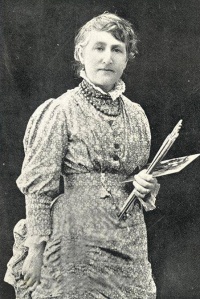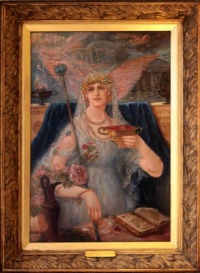Isabelle de Steiger
Isabelle de Steiger (1836–1927) was one of the earliest English Theosophists – an occultist, painter, and writer. She was a member of the Theosophical Society, the Hermetic Order of the Golden Dawn, and the Anthroposophical Society, and was a close friend of Anna Bonus Kingsford.
Personal life
Isabelle Lace was born on February 28, 1836 in Liverpool to Joshua Lace, a solicitor. The family had seven children.
She died on January 1, 1927 in Rock Ferry, Cheshire.
Theosophical Society involvement
Mme. de Steiger was admitted to the Theosophical Society in Birmingham, England on April 12, 1879, making her one of the earliest members of the Society. She resigned on June 28, 1905.[1] She introduced her neighbor Mabel Collins to Theosophy in 1881, when she loaded Mabel's husband Robert a copy of H. P. Blavatsky's first book Isis Unveiled.
Colonel Olcott wrote of a "friendly competition" in June, 1884,a psychic experiment among artists, to improve upon the portrait of Master M. drawn by Monsieur Harrisse six years earlier. Mme. de Steiger best captured "the luminous aura that shimmers about his head."[2] That same month, Olcott met Professor Elliott Coues for the first time, leading to Coues' membership and involvement in the Theosophical Society.
Mme. de Steiger was a member of the London Lodge and joined in signing a letter to Master K.H. and Master M. for permission to form an Inner Group for serious students of Theosophy, which was granted.
Other interests
Mme. de Steiger was active in several organizations. She joined the the Society for Psychical Research and the British National Association of Spiritualists, which later became the modern College of Psychic Studies. Through Theosophist Anna Bonus Kingsford, developed an in alchemy and joined The Hermetic Society]] that was founded by Dr. Kingsford.
In 1896 she translated and published a German work on mysticism by Karl von Eckartshausen. The Cloud upon the Sanctuary had a profound impact on modern occultism and especially on Aleister Crowley.
She became a close friend of the alchemist, Mary Anne Atwood. Atwood wrote the book A Suggestive Inquiry into the Hermetic Mystery that was printed in 1850. All copies were destroyed by her father, but after Atwood's death in 1910, Isabelle published the work with additional material.
Isabella joined the Golden Dawn in its first year of operation [1888]. She became an active member, attending meetings in London, Bradford and Edinburgh. She took her initiation into the Inner Order in 1896 and painted the Vault of the Adepts for the Scottish Lodge. In 1903 she joined Waite's offshoot of the Order.[3]
Art works
Isabelle de Steiger was quite a serious and well-regarded painter, but unfortunately few of her works still exist. Many were of an occult nature.
Isabella was certainly the most prominent Golden Dawn artist. She exhibited a lot, the National Art Gallery at the Victoria and Albert Museum holds records of her showing pictures on 60 to 70 occasions. Her works made frequent appearance in the big public exhibitions which selected entries on merit, such as the Manchester Art Gallery, the Liverpool Art Gallery, the Grovesnor Gallery in London and, most prestigious of all, the Royal Academy. Her work also featured in exhibitions by the Royal Society of British Artists, the Royal Hibernian Society, Royal Scottish Society, the Royal Institute of Oil Painters, the Royal Society of Birmingham Artists and the Society of Woman Artists. Her works appeared alongside those of the major artists of the day and sold for substantial prices. She was preparing for a one woman show, one of the very first to be accorded to a female artist, when a warehouse fire destroyed much of her output, seriously hindering her recognition as an artist and making her work very scarce now. A number of her pictures were reproduced in monochrome in the Unknown World, the journal edited by A.E. Waite.[4]
One of remaining oils is Castles in the Air.
The title Castles in the Air derives from a play by Ibsen, the Master Builder, first staged in 1893. This tells the story of a builder who falls to his death from his just finished church tower distracted by a temptress who encourages his hubris.... It was previously called the Lady of Illusion, The Greek Pilgrim's Progress... Neo-Platonic in nature, the allegorical description is highly reminiscent of astral visions. It describes how souls must drink of the chalice of the Lady of Delusion to achieve incarnation, but they drink error and ignorance. But then, by listening to their good genius, they can live righteously, reject of sham-culture, choose Good over Evil and then transcend this inherent quality of incarnation and achieve true happiness. This doctrine relates to the architecture of the Golden Dawn. There it is the Fall that has plunged man into error and ignorance and the initiations encourage the candidate to choose wisely and transcend the essentially illusory nature of "reality" and achieve adepthood. The "Good Genius" who gives instruction regarding the symbolism of the tablet in the Greek Pilgrim's Progress is corresponds with the Augoeides, or Holy Guardian Angel, with whom the candidate is brought into communication. But the picture is deeply ambiguous. The wings behind the lady of Illusion's head imply her transcendence, and she has the Golden Dawn wand and Isabella's magical motto engraved beyond her shoulder. As if to say "the nature of incarnation is to drink in Illusion and we swim in a world of Illusion. It is for us to skilfully marshal those illusions to enlighten ourselves and the world". This resonates with the Golden Dawn undertaking, which ultimately suggests the redemption of humanity by their own hand."[5]
Writings
- On a Gold Basis: A Treatise on Mysticism. London: Philip Wellby. 1907.
- Superhumanity. 1916.
- Memorabilia: Reminiscences of a Woman Artist and Writer. London: Rider & Co., 1927.
- A Suggestive Inquiry into the Hermetic Mystery: With a Dissertation on the More Celebrated of the Alchemical Philosophers Being an Attempt Towards the Recovery of the Ancient Experiment of Nature by Mary Anne Atwood. 1910. De Steiger was the editor.
- The Cloud upon the Sanctuary by Karl von Eckartshausen. 1896. Translated from German by Isabelle de Steiger.
Additional resources
- Goodrick-Clarke, Nicholas. "Western Esoteric Traditions and Theosophy" Handbook of the Theosophical Current (Leiden: Brill, 2013), 290-294.
Notes
- ↑ Theosophical Society General Membership Register, 1875-1942 at http://tsmembers.org/. See book 1, entry 187 (website file: 1A/14).
- ↑ Henry Steel Olcott, Old Diary Leaves Third Series (Adyar, Madras: The Theosophical Publishing House, 1972), 162-163.
- ↑ "Isabella de Steiger, Castles in the Air" at Caduceus Books website.
- ↑ "Isabella de Steiger, Castles in the Air" at Caduceus Books website.
- ↑ "Isabella de Steiger, Castles in the Air" at Caduceus Books website.

